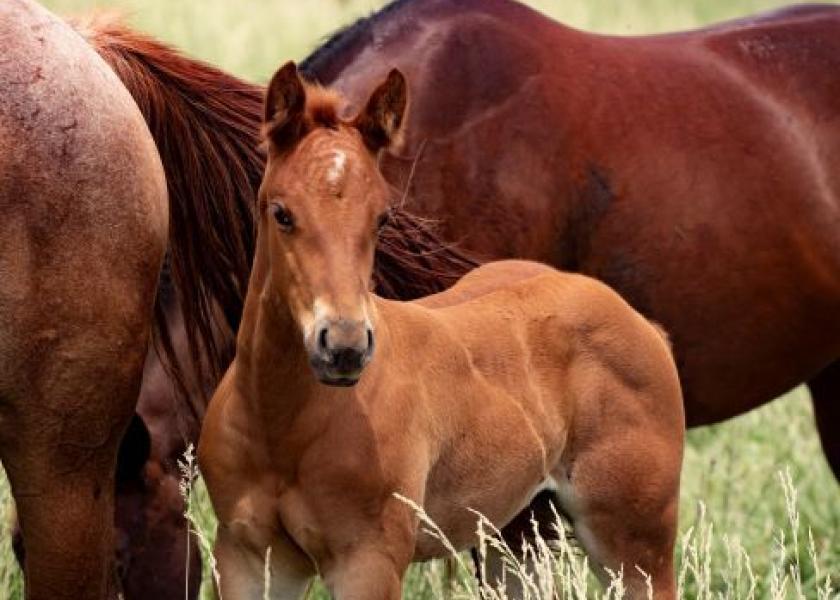Young Horse Health and Nutritional Needs Have Their Own Story

As young ranch horses dot fields, and horsemen dream big for their future, one cannot overemphasize the importance of their steps taken during these early years.
Bringing up a young horse requires consideration of many factors, most especially making good choices to support their health and nutrition. Below, Tony Hawkins, DVM, Valley Vet Supply Technical Service Veterinarian, outlines a young horse’s health needs. From strategic deworming and vaccination programs, to hoof health and more – a healthy start is crucial for your young horse. As is nutrition, explains Jyme Nichols, PhD, Stride Animal Health Director of Nutrition, who details appropriate nutritional programs for the young horse, and more, below.
Deworming
For our young horses, Dr. Hawkins warns that parasites are one of the greatest health concerns. Parasites can diminish a horse’s immunity, rob horses of nutrition, energy and overall wellness. They also can cause critical damage to a horse’s vital organs, hinder performance and impair growth.
“Parasites are a big consideration for the young horse – as early as 6 months old, their parasite risk changes from ascarids to strongyles. Because of this, a fecal egg count (FEC) is recommended around the weanling to yearling time frame,” said Dr. Hawkins. “For foals, I recommend deworming every two months until a year old. Foals are prone to ascarids early on, and benzimidazole dewormers (also known as ‘white dewormers’) are recommended. Yearlings and 2-year-olds should be dewormed on average three to four times per year, based on their FEC results, with either ivermectin or moxidectin and praziquantel for tapeworm control in the fall.”
Vaccinations
It’s important that you have proper vaccine protocols in place for your mares, foals and young horses, especially because at their young age, their immunity isn’t built up to protect them, cautions Dr. Hawkins.
“The consideration starts with the mare,” Dr. Hawkins said. “Make sure the mare is properly vaccinated, so the foals receive protection through colostrum. Assuming the mare was vaccinated appropriately, administer a vaccine booster at nine months of pregnancy – booster with a 4-way or 6- or 7- way. Whatever your mare is at risk for, your foal will be at risk for, as well.”
Once you welcome a healthy, new foal into the world, Dr. Hawkins recommends that “it’s best practice to vaccinate the foal at 4 months of age with the same product you used for your mare. Then, booster with that product at 6 months of age, then again as a yearling.”
Dental health
According to the American Association of Equine Practitioners (AAEP), a horse’s age matters in evaluating requirements for dental care. Young horses, such as 2- and 3-year-olds heading into training, will benefit from a comprehensive dental exam.
“Teeth should be floated to remove any sharp points and checked for retained caps. Caps should be removed if they have not been shed. This should be done before training begins to prevent training problems related to sharp teeth,” states the AAEP.
The AAEP also noted how young horses, between 2- and 5-year-olds, may require more attentive dental care.
“Deciduous teeth tend to be softer than permanent teeth and may develop sharp enamel points more quickly. Also, there is an extraordinary amount of dental maturation during this period. Twenty-four teeth will be shed and replaced by 36 to 40 adult teeth. To prevent maleruption problems, twice-a-year examinations are appropriate for young horses from birth to 5 years of age,” states AAEP’s article, “The Importance of Maintaining the Health of Your Horse's Mouth.”
General nutrition
“Once the foal is on the ground and weaned, don’t just kick them out to pasture,” warns Dr. Nichols. “The first 2 to 3 years is a critical phase where extra high levels of trace minerals and amino acids are needed to support proper bone and joint health.”
It’s important the young horse receive fortified feed with essential, single amino acid-bound trace minerals including copper, zinc and manganese. These will encourage maximum structural integrity.
“It does not matter how much glucosamine, MSM, chondroitin or hyaluronic acid you pump into a horse, if those basic trace minerals and amino acids are lacking, they will never reach full structural potential,” Dr. Nichols said.
For the young horse, it’s best to prioritize “Forage first. If green grass is an option, I’m a fan,” said Dr. Nichols. “Just keep in mind that grass, hay or alfalfa do not provide adequate trace mineral levels for a young horse. You must provide those critical nutrients through a fortified feed or a supplement. Work with an equine nutritionist to ensure levels of lysine, methionine, zinc, copper, manganese and selenium are included in the diet in proper levels and ratios. More is not always better!”
Healthy hooves
Though Biotin tends to get all the credit for this one, it is just one small piece of the puzzle, shared Dr. Nichols. Other nutrients of extreme importance for hoof health include zinc, copper, manganese, selenium, lysine and methionine.
“Researchers have found that providing 20 mg of biotin per day in the total diet (feed + supplements) is enough to significantly improve hoof quality. The catch is that you must continue the supplementation in order to benefit – reducing the amount or stopping will cause the quality to regress back to what it was. In addition, the improvements you see happen only in the new growth; it can take eight to 15 months for the hoof to grow completely out. Ramping the daily dose of biotin up to 100 mg may be helpful for horses that have exceptionally poor hoof quality or sole depth.
Biotin sounds like the magic fix, but don’t be fooled. A well-balanced diet is the crux to excellent hoof health,” encouraged Dr. Nichols.
Keep these thoughts in mind from Drs. Hawkins and Nichols to offer your young horse the best possible start. Learn more at ValleyVet.com.







